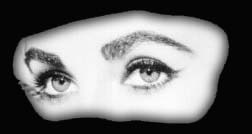|
1. Who wrote " in
the country of the blind, the one-eyed man is King"?
H.G.Wells.
In the story, a sighted man fell into the Valley of the Blind and fell
in love with a blind girl.
When faced with
the threat of losing his sight, he fled.
Recently, a newspaper
in Thailand was prosecuted for treason because the editor used the same
phrase. He was
thought to mock the King of Thailand who lost one of his eyes during a
car accident
while studying
medicine in Harvard.
2. In Balzac's short story "The Elixir of
Long Life". What happened to the eye of the dead man when his son
applied a magic potion over
it?
In
the story, a dying man asks his son to spread a magic potion over his corpse
to resurrect him. The
youth applies
it first to one eye. It opens, and all at once it is "thinking, accusing
condemning,
threatening,
judging, speaking, shouting and biting." The son shuts the eye and keeps
the elixir for
himself.
3. Who mused that "The soul, fortunately,
has an interpreter -- often an unconscious but still a faithful
interpreter -- in the
eye" ?
Jane Eyre. Unfortunately, her future husband Mr. Rochester lost his sight
in a house fire.
Mr. Rochester
is said by Charlotte Bronte to have dark eyes. A quick review of
Western literature
shows
that most women writers portray their heroes to have dark eyes. The psychologists
believe the
reasons
being men with dark eyes are perceived by women to have bigger pupils and
therefore more
caring
and romantic.
In human,
the pupils are profoundly expressive. These disks not only widen in dim
light but also before
an image
that excites us, as shrewd poker players and bargainers know. Antique hunters
are said to
prefer
dark glasses or colour contact lenses to hide their excitement during bargaining.
Researchers who
showed
men pairs of photos of women identical in every way except that retouchers
had enlarged the
pupils
of one, and found men preferred her but could not say why.
Our pupils
reach peak size in adolescence, almost certainly as a lure in love, then
slowly contract till age
sixty.
4. In La Vita Nuova who flashes love
from her eyes and inflames Dante?
Beatrice.
Love at first
sight usually involves eye contact, and the Greek poet Meleager (1st century
B.C) placed
Cupid inside
the eyes, whence he aimed his barbs. In much subsequent lover poetry, and
later among Arab
poets and Provencal
Versifiers of the 12th century, the eyes shoot arrows, darts, or fiery
beams that
wound the soul
and infect with longings.
5. What is " a green-eyed monster which doth mock
the meat it feeds on"?
Jealousy.
Iago blandly warns Othello that jealousy is "a green-eyed monster which
doth mock the meat
it feeds on." In China, covetousness is "red-eye disease".
6. Who wrote " Laugh, and the world laughs
with you;/ Weep, and you weep alone."?
Is this line, now a
maxim, literally true?
Ella Wheeler Wilcox (1850-1919). No.
This maxim
is literally untrue. Weeping actually brings people together. A crying
face in a child evokes
concern
in parents, and in an adult, compassion from others. The pull is arresting.
A person sobbing in a
supermarket,
for example, generates an instant circle of well wishers.
Handling a baby
chick, Lady Chatterley suddenly burst out crying "in all the anguish of
her generation's
forlornness,"
and the keeper touches her shoulder, a gesture of comfort that begins their
affair.
7. Who advised wooing men to shed tears? 
Ovid.
"They move
the most adamant natures. Let her, if possible, see tears on your cheeks,
in your eyes."
And if you can't produce tears at will, he says, bring a vial of water
and fake it.
8. Who observed that "the English wept less than
the Mediterranean"?
Darwin.
Culture
strongly conditions tears. One recent survey found that Israelis cry less
than Britons, possibly,
the authors suggest, because of mandatory military service in Israel, which
"encourages an active and
resourceful approach to the solution of problems and produces someone better
able to cope with
difficulties.
(DG Williams and G.H.Morris,
"Crying, Weeping or Tearfulness in British
and Israeli
Adults,"British Journal of Psychology, vol 87, pp 479-505, 1996)
Women cry
more often and longer than men. In one study they wept 5.3 times a month,
compared to 1.4
for men. They also use tears more commonly as a coping device, to win sympathy
and shame
malefactors.
(F de Fruyt, "Gender and Individual Differences in Crying. " Personality
and Individual Difference,
vol 22, no.6 pp. 937-940, 1997.)
Grief is not the sore cause of tears. Glory, success after extreme effort,
can bring tears. Perhaps the
oddest of all, music can cause tears. One duct-squeezing trick entails
repeating a musical theme a step
higher or lower than when the listener first heard it, as in Albinoni's
Adagio
for Strings. Another, even
more effective, is the appoggiatura, or delay in resolving a musical
theme. The Beatles' "Yesterday"
begins with one, and appoggiaturas abound in tear jerking tunes.
They build a kind of anxiety, which
the melody finally resolves.
| To verify
the above you may like to download "YESTERDAY" |
 |
|
|




